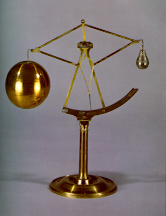
27 x 8.5 x 18.5
Brass, copper and lead
CAT. 1824 : H.II.78
Um apparelho, pelo qual se mostra, que os corpos do mesmo pezo, mas de differente volume, no ar, pezão dezigualmente no vacuo boyleano, porque no ar perdem partes deziguais do seu pezo. Está cuberto com um recipiente de vidro, e tem ao pé uma caxa de madeira, onde se pode pôr o apparelho para se transportar. - É um manómetro - Quebroce o recipiente na ispiriencia de 13 de Fevereiro de 1836.
An apparatus, by which it is shown, that bodies of the same weight, but of different volume in air, weigh unequally in the Boylean vacuum, because in the air they lose unequal parts of their weight. It is covered with a glass receptacle, and it has a wooden box, in which the apparatus can be placed for transportation. - It is a manometer - The receptacle broke in an experiment on 13th February 1836.
The "manometer", as the Catalogue of 1824 calls it, is used to demonstrate that two bodies that seemed to have the same weight in the air, do not. The two bodies suspended from the arms of the scales have different volumes. One of them is a hollow brass sphere, while the other is made of solid lead in the shape of a pear. If the baroscope is placed under a glass bell jar from which the air is extracted with a pneumatic pump, it becomes unbalanced, showing that the hollow sphere is heavier than the little body of lead.
With the experiment the teacher was able to demonstrate the importance of the impulsion of air on a brass sphere, which is more intense than the impulsion experienced by the little body suspended on the other arm of the scales. The experiment appears to suggest that the brass sphere became 'heavier' in a vacuum. Nevertheless, what in fact happens is that the real difference in weight of the two bodies is compensated by the difference in the impulsion exerted by the air on both. This difference in impulsion is due to the fact that the bodies possess different volumes and are surrounded by a homogeneous fluid.
This instrument was made in Lisbon by J. B. Haas at the beginning of the 19th century. The original bell jar broke during a physics class on 13th February 1836, a fact noted in the Index Catalogue of 1824. This apparatus continued to be used with another bell jar from the set belonging to the various pneumatic machines in the Physics Laboratory that were used for experiments requiring the rarefaction of air.
Sigaud de la Fond, Joseph-Aignan, Description et Usage d'un Cabinet de Physique Expérimental, Paris, 1775, Vol. I, Pl. XXXI, Fig. 8.Musschenbroek, Peter van, Essay de Physique, Leiden, 1739, Vol. II, Tab. IV, Fig. 34.